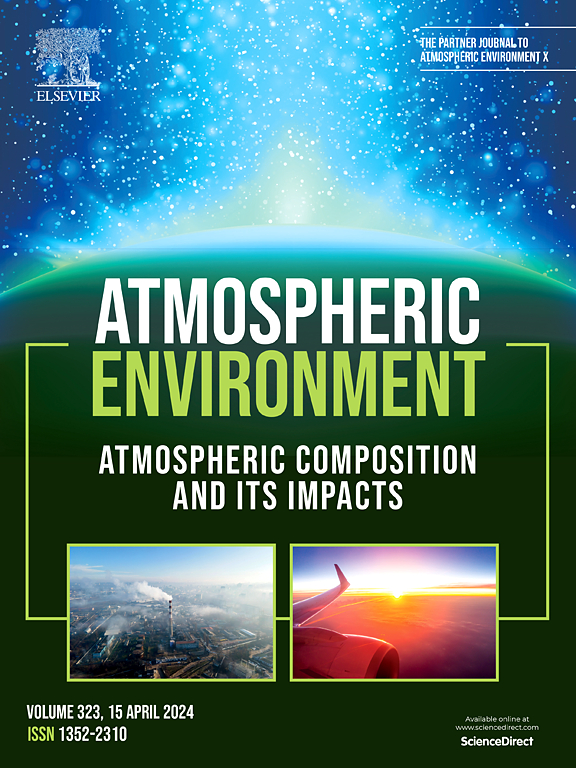基于静止卫星数据的增强型连续气溶胶光学深度(AOD)估计:聚焦于东亚夜间AOD
IF 3.7
2区 环境科学与生态学
Q2 ENVIRONMENTAL SCIENCES
引用次数: 0
摘要
由于来自自然和人为来源的大量气溶胶排放,在东亚进行持续的气溶胶监测至关重要。地球同步卫星能够持续监测气溶胶;然而,观测仅限于白天。本研究提出了基于机器学习的模型,利用地球同步卫星Geo-KOMPSAT-2A (GK-2A)估计东亚白天和夜间气溶胶光学深度(AOD)。机器学习模型的输入变量包括来自GK-2A的亮度温度(BT)和大气顶(TOA)反射率、气象和地理数据以及辅助变量。提出并比较了两种不同组合GK-2A变量的模型:利用BT变量估算白天和夜间AOD的全天BT模型,以及利用TOA反射率变量估算白天AOD的日间TOA模型。利用气溶胶机器人网络(AERONET)的地面AOD数据,通过10倍交叉验证和滞留验证方法对模型估计的AOD进行了验证。白天TOA模型在白天的表现略高于全天BT模型(R2 = 0.80-0.82,全天BT模型的均方根误差(RMSE) = 0.107-0.116,白天TOA模型的R2 = 0.83, RMSE = 0.098)。SHapley加性解释(SHapley Additive explanation, SHAP)分析表明,总可降水量和季节性对两个模型的影响最大。BT差异和TOA反射率变量被确定为全天BT和白天TOA模型的第二重要变量。与其他AOD产品相比,该模型估算的AOD的时空分布具有相似的模式。试验台站的时间序列对比表明,该模型的AOD估计值与AERONET AOD估计值一致。本文章由计算机程序翻译,如有差异,请以英文原文为准。
Enhanced continuous aerosol optical depth (AOD) estimation using geostationary satellite data: focusing on nighttime AOD over East Asia
Continuous aerosol monitoring in East Asia is essential due to the massive aerosol emissions from natural and anthropogenic sources. Geostationary satellites enable continuous aerosol monitoring; however, the observation is limited to the daytime. This study proposed machine learning-based models to estimate daytime and nighttime aerosol optical depth (AOD) in East Asia using a geostationary satellite, Geo-KOMPSAT-2A (GK-2A). The input variables for the machine learning models include the brightness temperature (BT) and top-of-atmosphere (TOA) reflectance from GK-2A, meteorological and geographical data, and auxiliary variables. The two models that used different combinations of GK-2A variables were proposed and compared: the all-day BT model, which estimates AOD during both day and night using BT variables, and the daytime TOA model, which estimates AOD during the day using TOA reflectance variables as well. The estimated AODs by the models were validated with ground-based AOD data from the Aerosol Robotic Network (AERONET) by 10-fold cross-validation and hold-out validation methods. The performance of the daytime TOA model was slightly higher than the all-day BT model during the day (R2 = 0.80–0.82, root mean square error (RMSE) = 0.107–0.116 for the all-day BT model, R2 = 0.83, RMSE = 0.098 for the daytime TOA model). The SHapley Additive exPlanations (SHAP) analysis showed that total precipitable water content and seasonality contributed the most for both proposed models. BT differences and TOA reflectance variables were identified as the next most contributing variables for the all-day BT and daytime TOA models. The spatiotemporal distributions of estimated AODs from the proposed models show similar patterns compared with other AOD products. A time series comparison at a test station demonstrated that the estimated AOD of the proposed models was consistent with the AERONET AOD.
求助全文
通过发布文献求助,成功后即可免费获取论文全文。
去求助
来源期刊

Atmospheric Environment
环境科学-环境科学
CiteScore
9.40
自引率
8.00%
发文量
458
审稿时长
53 days
期刊介绍:
Atmospheric Environment has an open access mirror journal Atmospheric Environment: X, sharing the same aims and scope, editorial team, submission system and rigorous peer review.
Atmospheric Environment is the international journal for scientists in different disciplines related to atmospheric composition and its impacts. The journal publishes scientific articles with atmospheric relevance of emissions and depositions of gaseous and particulate compounds, chemical processes and physical effects in the atmosphere, as well as impacts of the changing atmospheric composition on human health, air quality, climate change, and ecosystems.
 求助内容:
求助内容: 应助结果提醒方式:
应助结果提醒方式:


